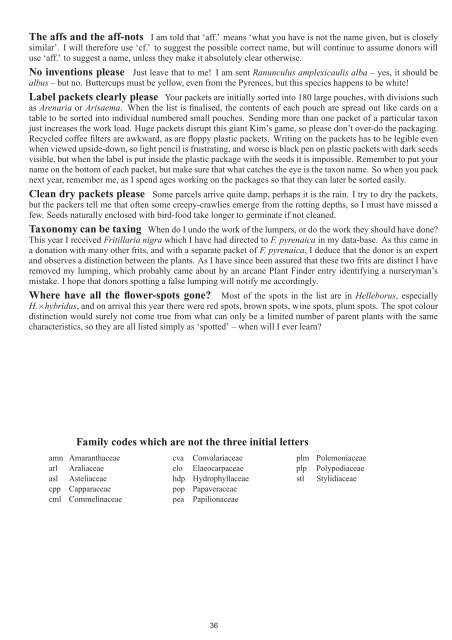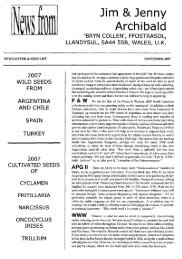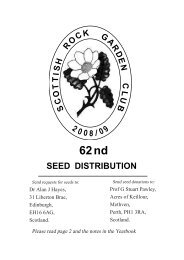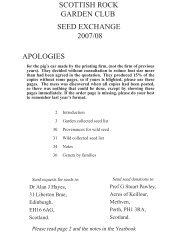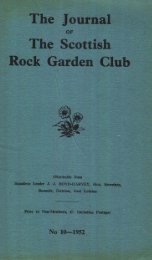The affs and <strong>the</strong> aff-nots I am told that ‘aff.’ means ‘what you have is not <strong>the</strong> name given, but is closely similar’. I will <strong>the</strong>refore use ‘cf.’ to suggest <strong>the</strong> possible correct name, but will continue to assume donors will use ‘aff.’ to suggest a name, unless <strong>the</strong>y make it absolutely clear o<strong>the</strong>rwise. No inventions please Just leave that to me! I am sent Ranunculus amplexicaulis alba – yes, it should be albus – but no. Buttercups must be yellow, even from <strong>the</strong> Pyrenees, but this species happens to be white! Label packets clearly please Your packets are initially sorted into 180 large pouches, with divisions such as Arenaria or Arisaema. When <strong>the</strong> list is finalised, <strong>the</strong> contents of each pouch are spread out like cards on a table to be sorted into individual numbered small pouches. Sending more than one packet of a particular taxon just increases <strong>the</strong> work load. Huge packets disrupt this giant Kim’s game, so please don’t over-do <strong>the</strong> packaging. Recycled coffee filters are awkward, as are floppy plastic packets. Writing on <strong>the</strong> packets has to be legible even when viewed upside-down, so light pencil is frustrating, and worse is black pen on plastic packets with dark seeds visible, but when <strong>the</strong> label is put inside <strong>the</strong> plastic package with <strong>the</strong> seeds it is impossible. Remember to put your name on <strong>the</strong> bottom of each packet, but make sure that what catches <strong>the</strong> eye is <strong>the</strong> taxon name. So when you pack next year, remember me, as I spend ages working on <strong>the</strong> packages so that <strong>the</strong>y can later be sorted easily. Clean dry packets please Some parcels arrive quite damp, perhaps it is <strong>the</strong> rain. I try to dry <strong>the</strong> packets, but <strong>the</strong> packers tell me that often some creepy-crawlies emerge from <strong>the</strong> rotting depths, so I must have missed a few. Seeds naturally enclosed with bird-food take longer to germinate if not cleaned. Taxonomy can be taxing When do I undo <strong>the</strong> work of <strong>the</strong> lumpers, or do <strong>the</strong> work <strong>the</strong>y should have done? This year I received Fritillaria nigra which I have had directed to F. pyrenaica in my data-base. As this came in a donation with many o<strong>the</strong>r frits, and with a separate packet of F. pyrenaica, I deduce that <strong>the</strong> donor is an expert and observes a distinction between <strong>the</strong> plants. As I have since been assured that <strong>the</strong>se two frits are distinct I have removed my lumping, which probably came about by an arcane Plant Finder entry identifying a nurseryman’s mistake. I hope that donors spotting a false lumping will notify me accordingly. Where have all <strong>the</strong> flower-spots gone? Most of <strong>the</strong> spots in <strong>the</strong> list are in Helleborus, especially H.×hybridus, and on arrival this year <strong>the</strong>re were red spots, brown spots, wine spots, plum spots. The spot colour distinction would surely not come true from what can only be a limited number of parent plants with <strong>the</strong> same characteristics, so <strong>the</strong>y are all listed simply as ‘spotted’ – when will I ever learn? Family codes which are not <strong>the</strong> three initial letters amn Amaranthaceae cva Convalariaceae plm Polemoniaceae arl Araliaceae elo Elaeocarpaceae plp Polypodiaceae asl Asteliaceae hdp Hydrophyllaceae stl Stylidiaceae cpp Capparaceae pop Papaveraceae cml Commelinaceae pea Papilionaceae 36
Genera by Families Acanthaceae Acanthus, Ruellia Aceraceae Acer Adoxaceae Adoxa Agavaceae Beschorneria, Yucca Aizoaceae Bergeranthus, Delosperma, Lampranthus Alliaceae Agapanthus, Allium, Bloomeria, Brodiaea, Caloscordum, Dichelostemma, Ipheion, Nectaroscordum, Nothoscordum, Tristagma, Triteleia, Tulbaghia Alstroemeriaceae Alstroemeria, Bomarea Amaranthaceae Ptilotus Amaryllidaceae Acis, Cyrtanthus, Galanthus, Habranthus, Hippeastrum, Leucojum, Narcissus, Nerine, Pancratium, Rhodophiala, Sprekelia, Sternbergia, Xerophyta, Zephyran<strong>the</strong>s Anacardiaceae Schinus Annonaceae Annona An<strong>the</strong>ricaceae An<strong>the</strong>ricum, Arthropodium, Pasi<strong>the</strong>a Apiaceae Aciphylla, Angelica, Anthriscus, Astrantia, Athamanta, Bupleurum, Cryptotaenia, Eryngium, Ferula, Foeniculum, Hacquetia, Kundmannia, Laserpitium, Lomatium, Magydaris, Meum, Myrrhis, Oreomyrrhis, Orlaya, Peucedanum, Pimpinella, Pleurospermum, Selinum, Smyrnium, Tordylium, Torilis Apocynaceae Amsonia Araceae Arisaema, Arisarum, Arum, Helicodiceros, Lysichiton, Pinellia, Symplocarpus, Zantedeschia Araliaceae Aralia Aristolochiaceae Aristolochia, Saruma Asclepiadaceae Asclepias, Cynanchum, Dregea, Tweedia Asphodelaceae Asphodeline, Asphodelus, Bulbine, Bulbinella, Eremurus, Kniphofia, Paradisea Asteliaceae Astelia Asteraceae Achillea, Adenostyles, Anacyclus, Anaphalis, Andryala, Antennaria, An<strong>the</strong>mis, Arctan<strong>the</strong>mum, Arctotis, Arnica, Artemisia, Aster, Athanasia, Baccharis, Bellis, Berardia, Berkheya, Berlandiera, Carduncellus, Carduus, Carlina, Carthamus, Catananche, Celmisia, Centaurea, Chaenactis, Cheirolophus, Chiliotrichum, Chrysopsis, Cichorium, Cirsium, Coreopsis, Cosmos, Cotula, Craspedia, Cremanthodium, Crepis, Cynara, Doronicum, Dugaldia, Echinacea, Echinops, Emilia, Erigeron, Eriophyllum, Felicia, Gaillardia, Galactites, Gazania, Gerbera, Haplopappus, Helenium, Helichrysum, Heteropappus, Hetero<strong>the</strong>ca, Hieracium, Hippolytia, Homogyne, Hymenoxys, Hypochaeris, Inula, Leibnitzia, Leontopodium, Leucogenes, Leuzea, Liatris, Ligularia, Malacothrix, Mantisalca, Mutisia, Olearia, Onopordum, Osteospermum, Otanthus, Ozothamnus, Pachystegia, Perezia, Pilosella, Ptilostemon, Pyrethrum, Pyrrocoma, Raoulia, Rhaponticum, Santolina, Saussurea, Scolymus, Scorzonera, Senecio, Serratula, Silybum, Sinacalia, Solidago, Sonchus, Sphaeromeria, Stokesia, Syneilesis, Tagetes, Tanacetum, Taraxacum, Telekia, Tetraneuris, Tonestus, Townsendia, Tragopogon, Verbesina, Xerochrysum, Zinnia Balsamaceae Impatiens Berberidaceae Jeffersonia, Mahonia, Podophyllum, Ranzania Betulaceae Betula Bignoniaceae Campsis, Eccremocarpus, Incarvillea, Tecoma Boraginaceae Anchusa, Arnebia, Borago, Buglossoides, Cerin<strong>the</strong>, Cynoglossum, Echium, Eritrichium, Lindelofia, Lithodora, Mertensia, Moltkia, Myosotidium, Myosotis, Omphalodes, Onosma, Pulmonaria, Solenanthus, Vella Brassicaceae Aethionema, Alyssoides, Alyssum, Arabis, Aubrieta, Aurinia, Barbarea, Braya, Carrichtera, Cerastium, Christolea, Coluteocarpus, Crambe, Degenia, Diplotaxis, Draba, Erysimum, Fibigia, Hesperis, Hugueninia, Iberis, Isatis, Lepidium, Lesquerella, Lunaria, Matthiola, Megacarpaea, Moricandia, Physaria, Pritzelago, Raffenaldia, Raphanus, Streptanthus, Thlaspi Buxaceae Sarcococca Cactaceae Echinocereus, Opuntia Caesalpiniaceae Cassia, Ceratonea, Cercis, Senna Calycanthaceae Chimonanthus Campanulaceae Adenophora, Asyneuma, Azorina, Campanula, Codonopsis, Cyananthus, Edraianthus, Isotoma, Jasione, Lobelia, Phyteuma, Platycodon, Symphyandra, Wahlenbergia Capparaceae Cleome Caprifoliaceae Kolkwitzia, Lonicera, Sambucus Caryophyllaceae Agrostemma, Arenaria, Dianthus, Gypsophila, Lychnis, Minuartia, Petrocoptis, Petrorhagia, Saponaria, Silene, Stellaria Casuarinaceae Casuarina Celastraceae Euonymus Chenopodiaceae Atriplex Cistaceae Cistus, Fumana, Halimium, Helian<strong>the</strong>mum, Tuberaria Clusiaceae Hypericum Cneoraceae Cneorum Colchicaceae Colchicum, Littonia, Merendera, Sandersonia, Wurmbea Commelinaceae Commelina, Pollia Convalariaceae Clintonia, Convallaria, Disporum, Maian<strong>the</strong>mum, Ophiopogon, Polygonatum, Smilacina, Tricyrtis Convolvulaceae Calystegia, Convolvulus, Ipomoea Cornaceae Cornus Crassulaceae Aeonium, Chiastophyllum, Orostachys, Phedimus, Rhodiola, Rosularia, Sedum, Sempervivum Cucurbitaceae Ecballium, Echinocystis Cupressaceae Cupressus Cyperaceae Carex, Eriophorum, Schoenus, Uncinia Diapensiaceae Shortia Dioscoreaceae Dioscorea Dipsaceae Cephalaria, Dipsacus, Knautia, Pterocephalus, Scabiosa, Succisa, Succisella Elaeocarpaceae Crinodendron Epacridaceae Cyathodes, Trochocarpa Ericaceae Erica, Gaul<strong>the</strong>ria, Kalmia, Ledum, Leucothoe, Loiseleuria, Menziesia, Phyllodoce, Pyrola, Rhododendron, Rhodothamnus, Vaccinium Escalloniaceae Corokia Euphorbiaceae Euphorbia Fumariaceae Adlumia Gentianaceae Centaurium, Gentiana, Gentianella, Gentianopsis Geraniaceae Erodium, Geranium, Monsonia, Pelargonium Gesneriaceae Briggsia, Chirita, Haberlea, Jancaemonda, Ramonda, Rhabdothamnus Glaucidiaceae Glaucidium Globulariaceae Globularia Haloragaceae Haloragis Hamamelidaceae Corylopsis, Hamamelis Hemerocallidaceae Hemerocallis Hostaceae Hosta Hyacinthaceae Albuca, Bellevalia, Bowiea, Brimeura, Camassia, Chionodoxa, Chionoscilla, Chlorogalum, Daubenya, Dipcadi, Eucomis, Galtonia, Hastingsia, Hyacin<strong>the</strong>lla, Hyacinthoides, Hyacinthus, Lachenalia, Massonia, Muscari, Muscarimia, Ornithogalum, Polyxena, Puschkinia, Scilla, Urginea, Vel<strong>the</strong>imia Hydrangeaceae Deinan<strong>the</strong>, Hydrangea, Kirengeshoma, Nemophila Hydrophyllaceae Hesperochiron, Phacelia, Romanzoffia Hypoxidaceae Hypoxis Illecebraceae Scleranthus Iridaceae Alophia, Anoma<strong>the</strong>ca, Belamcanda, Chasman<strong>the</strong>, Crocosmia, Crocus, Cypella, Dierama, Dietes, Diplarena, Freesia, Geissorhiza, Gelasine, Gladiolus, Herbertia, Hesperantha, Hexaglottis, Homeria, Iris, Ixia, Juno, Libertia, Melasphaerula, Moraea, Olsynium, Orthrosanthus, Pardancanda, Romulea, Schizostylis, Sisyrinchium, Sparaxis, Tigridia, Trimezia, Tritonia, Watsonia Ixioliriaceae Ixiolirion Juncaceae Luzula Lamiaceae Acinos, Agastache, Ballota, Betonica, Coleus, Dracocephalum, Elsholtzia, Eremostachys, Galeopsis, Horminum, Hyssopus, Lallemantia, Lamium, Lavandula, Leonotis, Leonurus, Lepechinia, Lycopus, Micromeria, Moluccella, Monarda, Nepeta, Perilla, Phlomis, Phyllophyton, Physostegia, Prunella, Salvia, Satureja, Scutellaria, Sideritis, Stachys, Teucrium, Thymbra, Thymus Lentibulariaceae Pinguicula Liliaceae Calochortus, Cardiocrinum, Erythronium, Fritillaria, Gagea, Lilium, Neobakeria, Nomocharis, Notholirion, Tulipa Limnanthaceae Limnan<strong>the</strong>s Linaceae Linum


